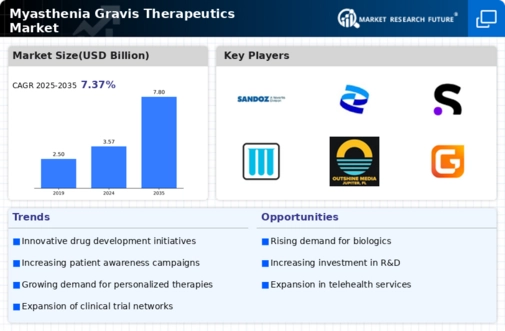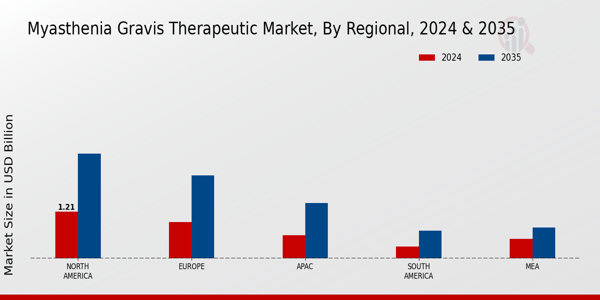Increased Awareness and Diagnosis
The heightened awareness surrounding Myasthenia Gravis is contributing to the growth of the Myasthenia Gravis Therapeutics Market. Educational initiatives aimed at both healthcare professionals and the general public are leading to earlier diagnosis and treatment of the disease. As more individuals recognize the symptoms and seek medical advice, the number of diagnosed cases is likely to rise. This trend is further supported by the development of improved diagnostic tools, which facilitate timely identification of the condition. Consequently, the demand for effective therapeutics is expected to increase, as newly diagnosed patients will require appropriate treatment options. The Myasthenia Gravis Therapeutics Market stands to gain from this increased awareness, as it drives the need for innovative therapies to meet the growing patient population.
Rising Prevalence of Myasthenia Gravis
The increasing incidence of Myasthenia Gravis appears to be a significant driver for the Myasthenia Gravis Therapeutics Market. Recent estimates suggest that the prevalence of this autoimmune disorder is rising, with approximately 20 cases per 100,000 individuals reported in various regions. This growing patient population necessitates the development and availability of effective therapeutic options. As awareness of the disease expands, more individuals are likely to seek diagnosis and treatment, further propelling market growth. The demand for innovative therapies, including monoclonal antibodies and immunosuppressants, is expected to increase as healthcare providers aim to improve patient outcomes. Consequently, the Myasthenia Gravis Therapeutics Market is poised for expansion, driven by the urgent need to address the challenges posed by this debilitating condition.
Advancements in Research and Development
Ongoing advancements in research and development are likely to play a crucial role in shaping the Myasthenia Gravis Therapeutics Market. The scientific community is increasingly focused on understanding the underlying mechanisms of Myasthenia Gravis, leading to the discovery of novel therapeutic targets. Recent studies have highlighted the potential of biologics and targeted therapies, which may offer more effective treatment options with fewer side effects. Investment in clinical trials is also on the rise, with numerous candidates currently undergoing evaluation. This influx of innovative therapies could significantly alter the treatment landscape, providing patients with more choices and potentially improving their quality of life. As a result, the Myasthenia Gravis Therapeutics Market is expected to benefit from these advancements, fostering a competitive environment that encourages further innovation.
Regulatory Support for Innovative Therapies
Regulatory bodies are increasingly supportive of the development of innovative therapies for Myasthenia Gravis, which may significantly impact the Myasthenia Gravis Therapeutics Market. Initiatives aimed at expediting the approval process for new drugs, particularly those addressing unmet medical needs, are becoming more common. This regulatory environment encourages pharmaceutical companies to invest in research and development, fostering the introduction of novel treatment options. Additionally, the potential for orphan drug designation for therapies targeting rare diseases like Myasthenia Gravis can provide financial incentives for developers. As a result, the Myasthenia Gravis Therapeutics Market is likely to experience a surge in new product launches, enhancing the therapeutic landscape and offering patients more effective solutions.
Growing Investment in Healthcare Infrastructure
The increasing investment in healthcare infrastructure is expected to bolster the Myasthenia Gravis Therapeutics Market. As healthcare systems expand and improve, access to diagnostic and therapeutic services for Myasthenia Gravis patients is likely to enhance. This investment encompasses the establishment of specialized clinics, improved training for healthcare professionals, and the integration of advanced technologies in treatment protocols. Furthermore, as healthcare systems prioritize chronic disease management, the focus on conditions like Myasthenia Gravis is likely to intensify. This trend may lead to a more robust market for therapeutics, as patients gain better access to care and treatment options. Consequently, the Myasthenia Gravis Therapeutics Market is poised for growth, driven by these infrastructural advancements.



















Leave a Comment